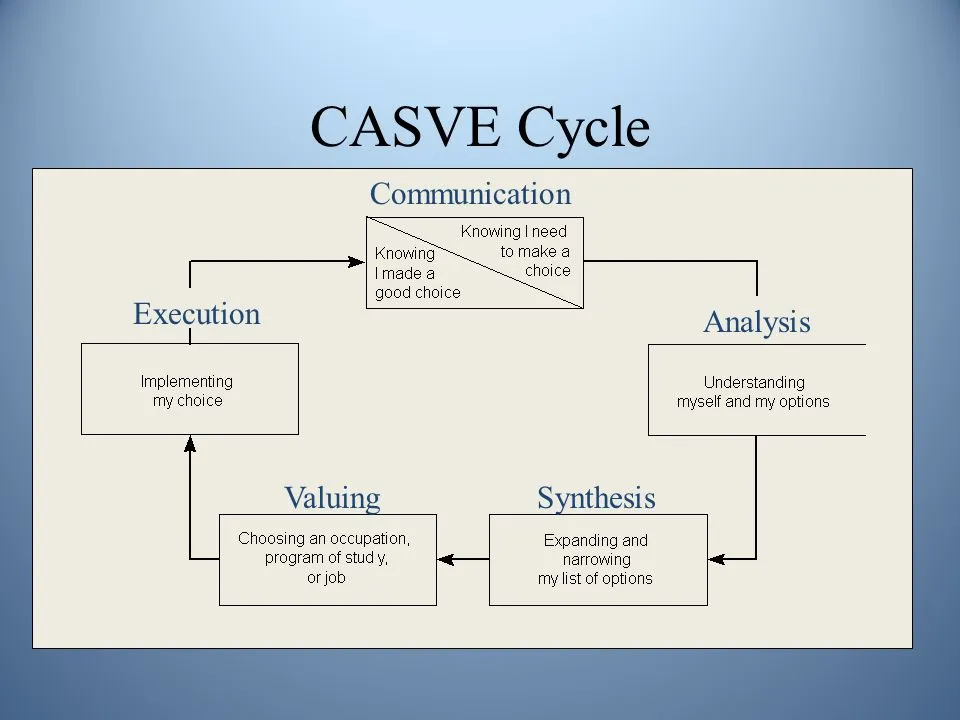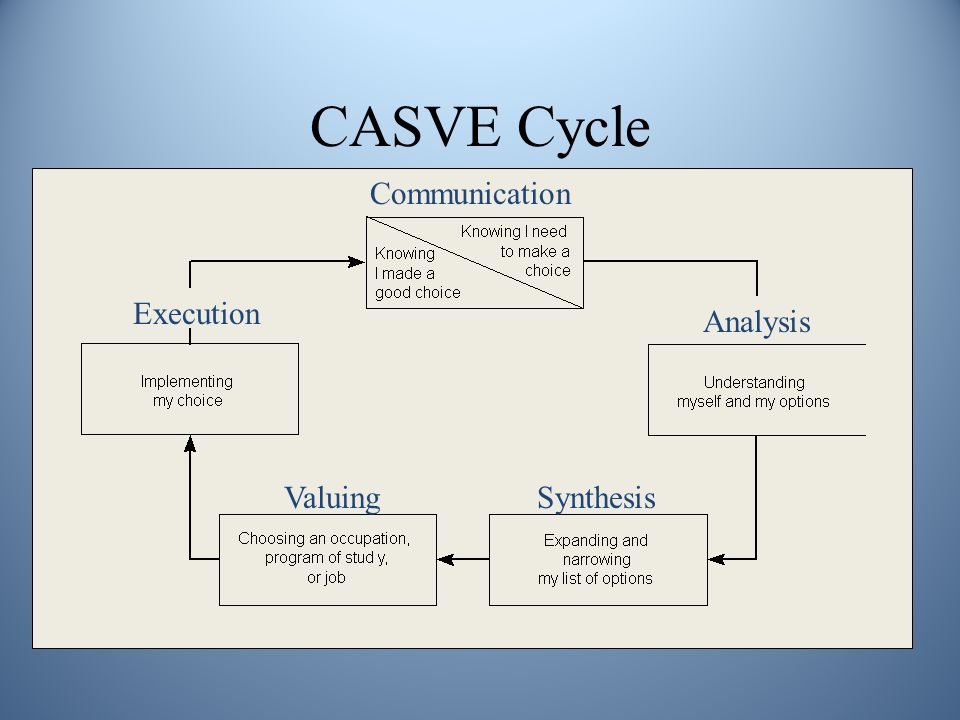
Florida State University has a world-renowned career center which pioneered the Cognitive Information Processing theory. According to Wikipedia, this “theory asserts that the major components involved in determining career decision-making and problem-solving effectiveness are the content and the process of career decisions. The importance of the content and process in career decision making can be described by using a metaphor of a recipe. To make a good dish (decision) one must have all necessary ingredients (content), and know how to follow cooking instructions (process).”
Today, we are going to focus on the instructions or the process. This process is something that everyone will continually navigate through their own career development. CIP theory has put forth a CASVE decision-making cycle to help understand this process. The CASVE Cycle is a good career decision-making model which focuses on action-oriented steps detailing what you need to do. In this cycle, the process is broken down into five stages.
Communication – Analysis – Synthesis – Valuing – Execution (CASVE)
 COMMUNICATION
“Identifying the problem or the gap”
This could be anything from “I need to find a new job” or “I have to choose a major”. It is important to be as specific as possible when identifying the presenting issue. According to the model, communication often boils down to external cues (events, significant others) and internal cues (emotions, physiological responses, and avoidance behavior).
ANALYSIS
“Understanding myself and my options”
This section focuses on self-knowledge like utilizing reflection, structured exercises, or even assessment instruments to gain more insights into your skills, values, and interests in order to gain more self-awareness. Knowledge about options can be gained by looking into more specifics about the options you have at hand. It might also be necessary to explore occupations, programs of study, and employers based on your skills, values, and interests which will help you understand the wide array of options available to you through your own personal filters/preferences.
SYNTHESIS
“Expanding and then narrowing my list of options”
In this stage, you are trying to elaborate on your options in order to then crystallize them into a manageable set of options. You are essentially checking for alternatives to see if there are other areas to explore. You can generate occupational, educational, and employment options by doing interest inventories like the Strong Interest Inventory, or other informal assessments online, as well as by doing informational interviews.
In the narrowing phase of this stage, you are tasked with identifying no more than three alternatives, occupational or otherwise.
VALUING
“Prioritizing alternatives”
Your prioritization of your educational, occupational, and employment alternatives conclude with an identification of your tentative primary and secondary choices.
This is accomplished by valuing the costs and benefits to: yourself, your significant others, your cultural group, your community and/or society at large.
EXECUTION
“Implementing my choice”
This stage is about making a plan for implementing your tentative primary choice. Three key factors in beginning the execution of your choice include: 1. Reality testing 2. Preparation program and 3. Employment/Education Seeking.
COMMUNICATION
“Identifying the problem or the gap”
This could be anything from “I need to find a new job” or “I have to choose a major”. It is important to be as specific as possible when identifying the presenting issue. According to the model, communication often boils down to external cues (events, significant others) and internal cues (emotions, physiological responses, and avoidance behavior).
ANALYSIS
“Understanding myself and my options”
This section focuses on self-knowledge like utilizing reflection, structured exercises, or even assessment instruments to gain more insights into your skills, values, and interests in order to gain more self-awareness. Knowledge about options can be gained by looking into more specifics about the options you have at hand. It might also be necessary to explore occupations, programs of study, and employers based on your skills, values, and interests which will help you understand the wide array of options available to you through your own personal filters/preferences.
SYNTHESIS
“Expanding and then narrowing my list of options”
In this stage, you are trying to elaborate on your options in order to then crystallize them into a manageable set of options. You are essentially checking for alternatives to see if there are other areas to explore. You can generate occupational, educational, and employment options by doing interest inventories like the Strong Interest Inventory, or other informal assessments online, as well as by doing informational interviews.
In the narrowing phase of this stage, you are tasked with identifying no more than three alternatives, occupational or otherwise.
VALUING
“Prioritizing alternatives”
Your prioritization of your educational, occupational, and employment alternatives conclude with an identification of your tentative primary and secondary choices.
This is accomplished by valuing the costs and benefits to: yourself, your significant others, your cultural group, your community and/or society at large.
EXECUTION
“Implementing my choice”
This stage is about making a plan for implementing your tentative primary choice. Three key factors in beginning the execution of your choice include: 1. Reality testing 2. Preparation program and 3. Employment/Education Seeking.
RESOURCES Florida State University has put many of its resources and handouts about the CASVE cycle online and they are free for the public to utilize. Take advantage of this handout which allows you to describe your own career problem solving and decision-making process using the CASVE Cycle. Another helpful resource is this exercise entitled "Guide to Good Decision-Making". It goes into more depth about each stage and even gives examples so you have a sense of how to complete this on your own. Remember, that every decision will have its pros and cons. Very rarely is there a perfect decision to me made; however, hopefully this model will make you feel like you have taken the time to make a fully informed and well-contemplated career decision.
 COMMUNICATION
“Identifying the problem or the gap”
This could be anything from “I need to find a new job” or “I have to choose a major”. It is important to be as specific as possible when identifying the presenting issue. According to the model, communication often boils down to external cues (events, significant others) and internal cues (emotions, physiological responses, and avoidance behavior).
ANALYSIS
“Understanding myself and my options”
This section focuses on self-knowledge like utilizing reflection, structured exercises, or even assessment instruments to gain more insights into your skills, values, and interests in order to gain more self-awareness. Knowledge about options can be gained by looking into more specifics about the options you have at hand. It might also be necessary to explore occupations, programs of study, and employers based on your skills, values, and interests which will help you understand the wide array of options available to you through your own personal filters/preferences.
SYNTHESIS
“Expanding and then narrowing my list of options”
In this stage, you are trying to elaborate on your options in order to then crystallize them into a manageable set of options. You are essentially checking for alternatives to see if there are other areas to explore. You can generate occupational, educational, and employment options by doing interest inventories like the Strong Interest Inventory, or other informal assessments online, as well as by doing informational interviews.
In the narrowing phase of this stage, you are tasked with identifying no more than three alternatives, occupational or otherwise.
VALUING
“Prioritizing alternatives”
Your prioritization of your educational, occupational, and employment alternatives conclude with an identification of your tentative primary and secondary choices.
This is accomplished by valuing the costs and benefits to: yourself, your significant others, your cultural group, your community and/or society at large.
EXECUTION
“Implementing my choice”
This stage is about making a plan for implementing your tentative primary choice. Three key factors in beginning the execution of your choice include: 1. Reality testing 2. Preparation program and 3. Employment/Education Seeking.
COMMUNICATION
“Identifying the problem or the gap”
This could be anything from “I need to find a new job” or “I have to choose a major”. It is important to be as specific as possible when identifying the presenting issue. According to the model, communication often boils down to external cues (events, significant others) and internal cues (emotions, physiological responses, and avoidance behavior).
ANALYSIS
“Understanding myself and my options”
This section focuses on self-knowledge like utilizing reflection, structured exercises, or even assessment instruments to gain more insights into your skills, values, and interests in order to gain more self-awareness. Knowledge about options can be gained by looking into more specifics about the options you have at hand. It might also be necessary to explore occupations, programs of study, and employers based on your skills, values, and interests which will help you understand the wide array of options available to you through your own personal filters/preferences.
SYNTHESIS
“Expanding and then narrowing my list of options”
In this stage, you are trying to elaborate on your options in order to then crystallize them into a manageable set of options. You are essentially checking for alternatives to see if there are other areas to explore. You can generate occupational, educational, and employment options by doing interest inventories like the Strong Interest Inventory, or other informal assessments online, as well as by doing informational interviews.
In the narrowing phase of this stage, you are tasked with identifying no more than three alternatives, occupational or otherwise.
VALUING
“Prioritizing alternatives”
Your prioritization of your educational, occupational, and employment alternatives conclude with an identification of your tentative primary and secondary choices.
This is accomplished by valuing the costs and benefits to: yourself, your significant others, your cultural group, your community and/or society at large.
EXECUTION
“Implementing my choice”
This stage is about making a plan for implementing your tentative primary choice. Three key factors in beginning the execution of your choice include: 1. Reality testing 2. Preparation program and 3. Employment/Education Seeking.
RESOURCES Florida State University has put many of its resources and handouts about the CASVE cycle online and they are free for the public to utilize. Take advantage of this handout which allows you to describe your own career problem solving and decision-making process using the CASVE Cycle. Another helpful resource is this exercise entitled "Guide to Good Decision-Making". It goes into more depth about each stage and even gives examples so you have a sense of how to complete this on your own. Remember, that every decision will have its pros and cons. Very rarely is there a perfect decision to me made; however, hopefully this model will make you feel like you have taken the time to make a fully informed and well-contemplated career decision.




